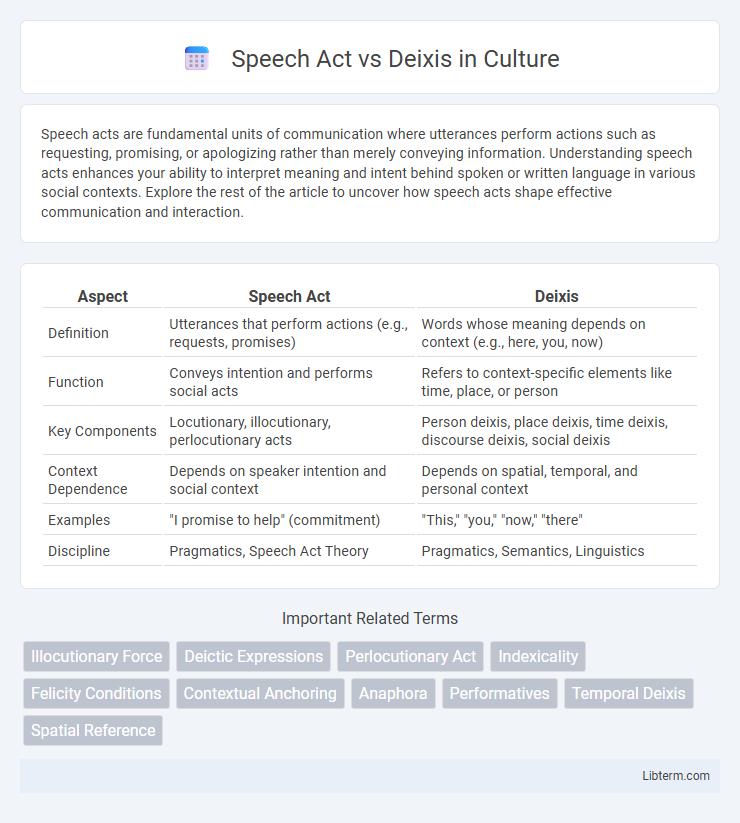Speech acts are fundamental units of communication where utterances perform actions such as requesting, promising, or apologizing rather than merely conveying information. Understanding speech acts enhances your ability to interpret meaning and intent behind spoken or written language in various social contexts. Explore the rest of the article to uncover how speech acts shape effective communication and interaction.
Table of Comparison
| Aspect | Speech Act | Deixis |
|---|---|---|
| Definition | Utterances that perform actions (e.g., requests, promises) | Words whose meaning depends on context (e.g., here, you, now) |
| Function | Conveys intention and performs social acts | Refers to context-specific elements like time, place, or person |
| Key Components | Locutionary, illocutionary, perlocutionary acts | Person deixis, place deixis, time deixis, discourse deixis, social deixis |
| Context Dependence | Depends on speaker intention and social context | Depends on spatial, temporal, and personal context |
| Examples | "I promise to help" (commitment) | "This," "you," "now," "there" |
| Discipline | Pragmatics, Speech Act Theory | Pragmatics, Semantics, Linguistics |
Introduction to Speech Act and Deixis
Speech Act theory explores how utterances function not only to convey information but also to perform actions such as requesting, promising, or apologizing, emphasizing the intent behind speech. Deixis refers to words and phrases, like "this," "that," "here," and "now," whose meaning depends on the contextual situation of the utterance, including the speaker's location and time. Both concepts are fundamental in pragmatics, helping to analyze how meaning is constructed and interpreted in communication.
Defining Speech Act Theory
Speech Act Theory, developed by J.L. Austin and further expanded by John Searle, analyzes how utterances function as actions rather than mere statements, emphasizing the performative nature of language. It categorizes speech acts into locutionary acts (the actual utterance), illocutionary acts (intended meaning or function), and perlocutionary acts (effects on the listener). This theory contrasts with deixis, which focuses on context-dependent expressions that anchor speech in time, place, and participants rather than on the action performed through speech.
Understanding Deixis in Linguistics
Deixis in linguistics refers to words and phrases, such as pronouns and time adverbs, that require contextual information to convey meaning, indicating elements like person, place, and time relative to the speaker. Understanding deixis is essential for interpreting utterances accurately, as these indexicals depend on the situational context to resolve references. Speech acts, by contrast, focus on the functional aspect of language use, emphasizing intentions behind utterances rather than the contextual anchors that deixis provides.
Types of Speech Acts
Speech acts are categorized into types such as locutionary acts, illocutionary acts, and perlocutionary acts, each representing different aspects of communication: producing utterances, performing intended actions, and causing effects, respectively. Illocutionary acts further divide into assertives, directives, commissives, expressives, and declarations, which convey statements, requests, promises, emotions, and changes in social reality. Deixis, unlike speech acts, relates to linguistic elements that depend on context, such as person, place, and time references, and does not classify action types but rather anchors utterances to situational parameters.
Categories of Deixis
Categories of deixis include person deixis, which refers to participants in the communication such as speaker, addressee, and others; place deixis, indicating spatial location relative to the speaker's position; and time deixis, involving references to temporal points like now, then, or soon. Speech acts differ as they represent communicative intentions like asserting, questioning, or commanding rather than situational references. Understanding deixis categories enhances interpretation of meaning based on context, while speech acts focus on the function of utterances in communication.
Key Differences Between Speech Act and Deixis
Speech acts are communicative actions performed through utterances, such as requesting, promising, or apologizing, reflecting the speaker's intentions and social functions. Deixis refers to words or phrases that require contextual information to be understood, including demonstratives, personal pronouns, and temporal adverbs that point to aspects of the speech situation like time, place, or identity. The key difference lies in speech acts expressing intended illocutionary force, while deixis deals with contextual anchoring of meaning.
Speech Act and Deixis in Communication Contexts
Speech acts involve the intentional use of language to perform actions such as requesting, promising, or apologizing, playing a crucial role in communication by conveying speakers' intentions and influencing listeners' responses. Deixis refers to words and phrases, like "here," "now," and "you," whose meanings depend on the speaker's context, anchoring utterances in time, place, and social relationships. Understanding both speech acts and deixis is essential in communication contexts to accurately interpret meaning and ensure effective interaction based on situational cues and conversational goals.
Pragmatic Functions of Speech Act and Deixis
Speech acts serve pragmatic functions by enabling speakers to perform actions such as requesting, promising, or apologizing through utterances, directly influencing the listener's interpretation and response in communication. Deixis functions pragmatically by anchoring expressions to the context of the utterance, such as time, place, and participants, allowing interlocutors to infer meaning based on situational cues. Together, speech acts and deixis coordinate speaker intentions and contextual references, facilitating effective and contextually appropriate communication.
Examples Illustrating Speech Act vs Deixis
Speech acts involve actions performed via utterances, such as requesting, promising, or apologizing, exemplified by "Can you pass the salt?" as a request. Deixis refers to words or phrases, like "here," "now," or "you," whose meanings depend on the speaker's context, as in "I am here now." For example, the utterance "I promise to come tomorrow" is a speech act expressing a commitment, whereas "I will see you there" relies on deixis for interpreting "I," "you," and "there" based on situational context.
Conclusion: Integrating Speech Act and Deixis in Analysis
Integrating speech act theory and deixis provides a comprehensive framework for understanding meaning in communication by linking speakers' intentions with contextual references. Speech acts reveal the illocutionary force behind utterances, while deixis grounds meaning in time, place, and identity. Together, they enhance pragmatic analysis by capturing the dynamic interaction between language use and situational context.
Speech Act Infographic

 libterm.com
libterm.com